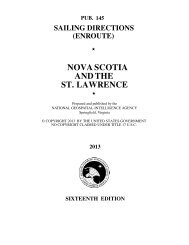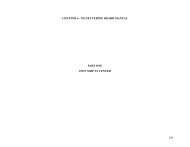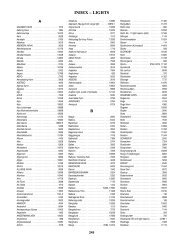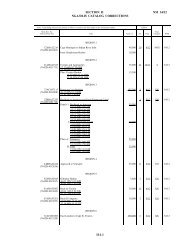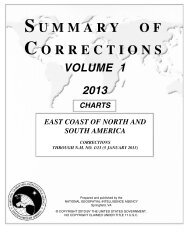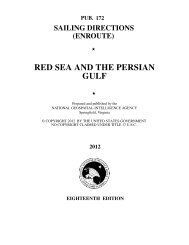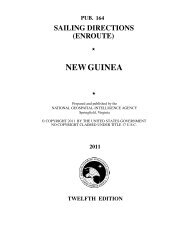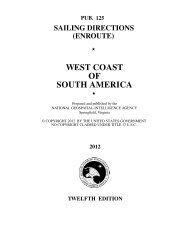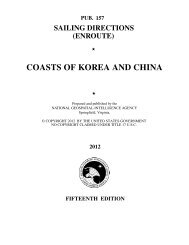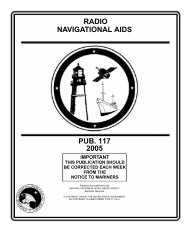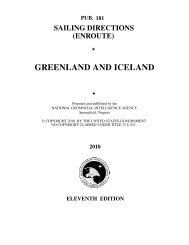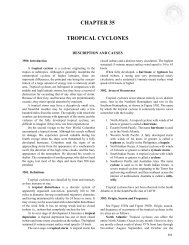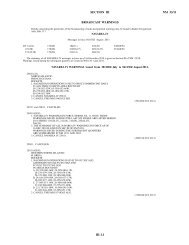LIST OF LIGHTS - Maritime Safety Information - National Geospatial ...
LIST OF LIGHTS - Maritime Safety Information - National Geospatial ...
LIST OF LIGHTS - Maritime Safety Information - National Geospatial ...
You also want an ePaper? Increase the reach of your titles
YUMPU automatically turns print PDFs into web optimized ePapers that Google loves.
Submarine signals–multiply the observed numbers of<br />
seconds by 0.8 or divide by 1.25 distance in nautical miles.<br />
Air signals–multipy the observed number of seconds by<br />
0.18 or divide by 5.5. For more approximate results or for<br />
statute miles, multiply the observed number of seconds by<br />
0.2 or divide by 5.<br />
Interval in<br />
seconds<br />
Tables for finding distance<br />
Distances in nautical miles from<br />
sound signal source<br />
Air Submarine<br />
1 0.18 0.8<br />
2 0.36 1.6<br />
3 0.54 2.4<br />
4 0.72 3.2<br />
5 0.90 4.0<br />
6 1.08 4.8<br />
7 1.26 5.6<br />
8 1.44 6.4<br />
9 1.62 7.2<br />
10 1.80 8.0<br />
20 3.60 16.0<br />
30 5.40 24.0<br />
40 7.20<br />
50 9.00<br />
60 10.80<br />
REMARKS: Average speed of sound travel in water is 1<br />
nautical mile in 11/4 seconds.<br />
The speed of sound travel is influenced by a number of<br />
conditions making it impracticable to state a factor that<br />
will give exact results under all conditions. The results<br />
obtained by the methods described may be accepted as<br />
being accurate to within 10 percent of the distance.<br />
Methods of synchronizing the signals vary and are<br />
described or illustrated in official announcements regarding<br />
them. It is essential to note carefully the point of synchronization<br />
used so that no error will be made through<br />
taking time on the wrong signal or the wrong part of it.<br />
In observing air signals it is usually sufficient to use a<br />
watch with second hand, although a stop watch is helpful.<br />
For submarine signals where the interval is shorter and a<br />
time error correspondingly more important, it is essential<br />
that a stop watch or other timing device be used. Where<br />
the radiobeacon and submarine signals are not received at<br />
the same point on the vessel, means of instant communication<br />
between two observers should be available or synchronized<br />
stop watches provided for each.<br />
Ships not equipped with a DF receiver can take advantage<br />
of the distance-finding feature of a radiobeacon station,<br />
if equipped with a radio receiver capable of receiving<br />
XXII<br />
the transmission. In the case of obtaining distance from a<br />
radiobeacon station which is synchronized with a submarine<br />
sound signal, the ship must also be equipped with a<br />
device for picking up submarine sound signals.<br />
Rotating Loop Radiobeacon<br />
MODE <strong>OF</strong> OPERATION:<br />
(1) The radiobeacon consists of a rotating loop transmitter<br />
having directional properties by which an observer<br />
in a ship can obtain his bearing from the beacon without<br />
the use of a direction-finder. Any ordinary receiving set<br />
capable of being tuned to the radiobeacon’s frequency<br />
may be used. The only other equipment required is a reliable<br />
stop watch or chronograph with a sweep second hand.<br />
Stop watches and clocks with dials graduated in degrees<br />
may be used, from which bearings may be read directly<br />
without any mathematical calculation.<br />
(2) During each revolution of the beacon, the signals<br />
received by the observer will rise and fall in intensity,<br />
passing through a maximum and a minimum twice each<br />
minute. The positions of minimum intensity, which occur<br />
at intervals of thirty seconds from one another, are very<br />
sharp and can be accurately observed. These are, therefore,<br />
used for navigation purposes.<br />
The beacon may be regarded as having a line or beam of<br />
minimum intensity which rotates at a uniform speed of<br />
360° in 1 minute (i.e. 6° in 1 second) based on the true<br />
meridian as starting point. Therefore, if the observer can<br />
(a) identify the beacon and (b) measure the number of seconds<br />
which this minimum beam takes to reach their position<br />
starting from the true meridian, this number<br />
multiplied by six will give their true bearing from the beacon<br />
or its reciprocal.<br />
The signals which enable the beacon to be identified<br />
and the bearing to be calculated are described in the following<br />
paragraphs:<br />
Signals transmitted by the beacon: Each transmission<br />
from the beacon lasts for 4 minutes; the beacon is then silent<br />
for 8 minutes, and automatically starts again at the end of<br />
the silent period. Each transmission consists of two parts:<br />
(a) the identification signal of the station set at a slow speed<br />
for the first minute, commencing when the minimum beam<br />
is true east and west and followed by a long dash of about<br />
12 seconds duration; (b) the signal group commencing<br />
when the minimum beam is approaching the true meridian,<br />
and consisting of (i) the north starting signal, which is the<br />
letter V followed by two dots ( – ); (ii) a long dash of<br />
about 12 seconds duration; (iii) the east starting signal,<br />
which is the letter B followed by two dots (– ); and (iv)<br />
a long dash for about 42 seconds.<br />
The navigation signals are repeated during the remainder<br />
of the transmission and signals cease when the minimum<br />
beam is in the east and west position.



